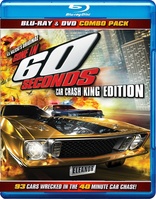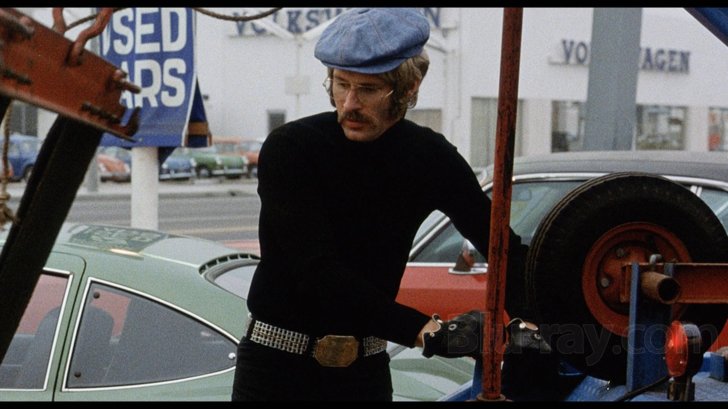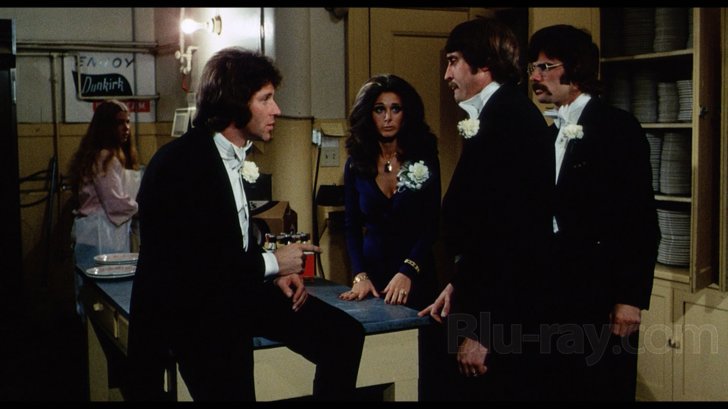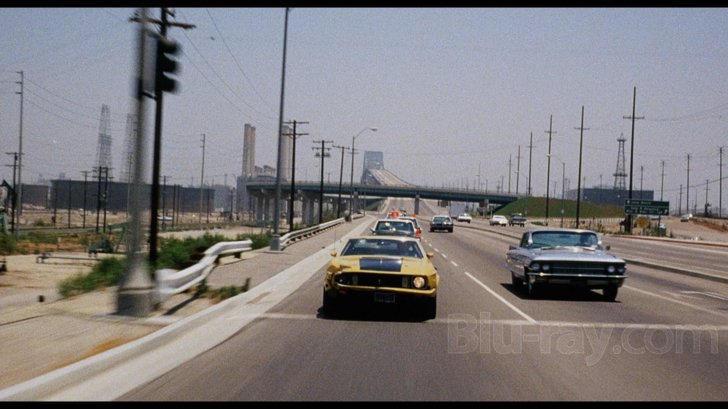Gone in 60 Seconds Blu-ray Movie
HomeGone in 60 Seconds Blu-ray Movie 
1974 / Blu-ray + DVDAnderson Merchandise | 1974 | 98 min | Rated PG | Oct 16, 2012

Movie rating
6.7 | / 10 |
Blu-ray rating
| Users | 2.5 | |
| Reviewer | 3.5 | |
| Overall | 3.3 |
Overview
Gone in 60 Seconds (1974)
Insurance investigator Maindrian Pace and his team lead double lives as unstoppable car thieves. When a shady Argentine buyer puts down $200,000 on a 48-car order, Pace and his crew race to deliver. As Pace himself prepares to steal the final car, a 1973 Ford Mustang codenamed "Eleanor", he is unaware that his business partner has tipped off the police after a dispute.
Starring: H.B. Halicki, Marion Busia, Jerry Daugirda, James McIntyre, George Cole (VI)Director: H.B. Halicki
| Crime | Uncertain |
| Drama | Uncertain |
| Action | Uncertain |
Specifications
Video
Video codec: MPEG-4 AVC
Video resolution: 1080p
Aspect ratio: 1.84:1
Original aspect ratio: 1.85:1
Audio
English: DTS 5.1 (755 kbps)
English: Dolby Digital 5.1 (640 kbps)
English: Dolby Digital 2.0
Subtitles
None
Discs
25GB Blu-ray Disc
Two-disc set (1 BD, 1 DVD)
DVD copy
Playback
Region free
Review
Rating summary
| Movie | 3.5 | |
| Video | 3.5 | |
| Audio | 3.0 | |
| Extras | 3.0 | |
| Overall | 3.5 |
Gone in 60 Seconds Blu-ray Movie Review
Eleanor Rigged Me
Reviewed by Michael Reuben October 18, 2012Millions of viewers know the Jerry Bruckheimer-produced Gone in 60 Seconds starring Nicolas Cage and Angelina Jolie, but many don't know that it's a remake. Fewer still have seen the no-budget 1974 original, because it was a truly independent production at a time when the notion of "independent cinema" didn't exist. Writer, producer, director and star H.B. "Toby" Halicki had no money and zero experience in filmmaking, but he loved cars and he wanted to make the greatest car chase film of all time. One can debate whether Gone, with its concluding 40-minute pursuit, is the "greatest" of all car chase films, but there's no arguing that it's one-of-a-kind. Among other things, no one today would take the kind of crazy risks that Halicki took in the real locations he and his amateur crew "borrowed", usually on Sunday when the permit inspector wasn't working. Halicki had moved to California from Dunkirk, New York, a location he made a point of including in Gone. He'd grown up in the family towing business, and in California he started a body shop. By the time he made Gone, he was doing the kind of insurance work that his character in the film performs as a cover for his real business, which is auto theft. No one ever proved that Halicki based that part of Gone on his own life, but his knowledge of then-current car theft techniques was so extensive that rumors abounded after the film was released. Of course, after the film's enormous success (of which Halicki kept most of the profits, because no studio was involved), Halicki was wealthy enough to indulge his passion for cars and other collectibles without having to do anything else. Still, the appetite for filmmaking endured. In 1982, he made another car chase extravaganza called The Junkman. In 1989, he began production on a sequel to Gone, during which he was killed on the set by an accident that, in a tragic irony, did not even involve an automobile. (Halicki's widow, Denice, who escaped without injury, recounts the incident in the disc's extras.)

The film's editor, Warner E. Leighton, was one of the few members of the crew with mainstream experience, and he relates in his commentary how Halicki's footage came to him in unlabeled boxes, in random order, with almost no guidance on how to assemble it. Halicki had a story, but it was mostly in his head. He also had an uncanny ability to persuade people to do what he wanted, whether it was to join him in a working on a dangerous enterprise for the sheer thrill of it or to lend him cars, trucks, locations and costumes for "just a day" (which sometimes extended into weeks). The concluding chase scene involving dozens of police and other vehicles pursuing Halicki in the 1973 Mustang known as "Eleanor" (which got top billing) was filmed first, because the whole movie built to it. The rest of the story was flexible. Gone opens with a scene that Halicki invented one day, when he heard on the radio that a train wreck had occurred and raced there with his crew to get free production value. Insurance investigator Maindrian Pace drives up to the wreck, shakes hands, exchanges words and gathers information about the accident. This is Pace's day job: reporting on accidents and their cause for insurers which will be called to pay on policies and are looking for reasons not to. Pace's real job is stealing cars, and when he gets back to his office/garage, his team is hard at work. Led by old-timer Atlee Jackson (George Cole), they are stripping down junkers bought at auction so that they can swap VIN numbers and other identifying information with the cars they boost. Jackson explains the process to a relative newcomer, and if you're paying attention, you can spot how editor Leighton solved a lot of his problems. What sounds like dialogue is really voiceover that plays across a tightly edited scene of men working. Go back and look at the train wreck scene, and you'll see the same technique. Leighton uses the same trick repeatedly in the first half of Gone, and he does it so well that it's almost invisible. Pace takes an unusually large order, with a substantial downpayment, for a specific list of cars from some Argentinian gentlemen who require that he meet a definite timetable. They also make it clear that the consequences for missing the deadline will be severe (and final). Pace and Jackson assign each item on the list a woman's name as a code, which is how the Mustang becomes "Eleanor". Pace leaves Jackson to begin "assembling" the order, while he and his three co-owners, Eugene, Stanley and Pumpkin Chase (Jerry Daugirda, James McIntyre and Marion Busia), fly east to attend Eugene's wedding in Dunkirk. The wedding scene appears in Gone for two reasons. The first is that Halicki wanted to include his home town and family in the film, and he thought a Polish-American wedding similar to the Italian-American wedding in The Godfather would be ideal. The second is that Pace tells Eugene he has to postpone his honeymoon, because all hands are needed in California to fill the Argentine order. Eugene takes the news poorly, and thus begins a conflict that is essential to the rest of the film. Back in California, various adventures provide the warm-up to the main event. These include an aborted attempt to acquire Eleanor and the recovery of a restored junker that was inadvertently sold to a dealership, thereby potentially raising suspicion. A special highlight is Pace's visit as an insurance investigator to the office of legendary driver Parnelli Jones, who wants his Range Rover recovered. Pace keeps a straight face, knowing full well that it was his people who stole it. Eventually the tension between Pace and Eugene explodes over a white Cadillac with a surprise in the trunk: a load of heroin that Eugene wants to sell for a quick profit, but Pace wants no part of. They come to blows, and Eugene is so angry that he phones an anonymous tip to the cops about when and where Pace will steal the last car: the elusive Eleanor. An unmarked cruiser stakes out the spot in Long Beach. "I should have read my horoscope this morning", says Pace, when he sees them—and they're off. I won't recite the various statistics or describe all the wild events in Gone's unique chase scene, which includes many things that weren't supposed to happen. (Recovering consciousness after one particularly serious mishap in Eleanor, Halicki's first words were, "Did we get coverage?" They did. It's in the movie.) The element that struck me watching Gone today is how differently it was shot. So much of contemporary chase scenes occurs in close-up, either because of green screen work, or to allow the actors to participate safely, or simply because close-up is the default style. Halicki didn't much care about close-ups. He wanted to capture cars moving fast, often at speeds of 100mph, which meant long shots, in which you can see where Pace and Eleanor are moving relative to their pursuers and understand how the chase is developing. That rarely happens in contemporary film. (It certainly wasn't common in the Nicolas Cage remake.) Just as it was in 1974, when Halicki was taking the film around from theater to theater and promoting it himself, Gone in 60 Seconds remains a distinctive and personal film with a style all its own—not exactly professional, but not the work of an amateur either. I doubt that Halicki would have called himself an auteur, but that doesn't make him any less of one.
Gone in 60 Seconds Blu-ray Movie, Video Quality 

Outcries are already being heard over Halicki Films's 1080p, AVC-encoded Blu-ray presentation of Gone in 60 Seconds. My favorite observation so far is from a user review that complains: "When ya shot [sic] on 35 mm film and blow it up you also blow up the grain"—which is the equivalent of saying a rose is a rose. For most of the last century, movies were shot on 35mm film, which recorded the imagery on "grain" (which is what film is made of), and that imagery was then "blown up" for projection onto screens much larger than most display devices used by people who watch Blu-ray. Some of the images on those big screens were grainier than others. Some of them were darker than others. Some had weaker and some had stronger colors. The image on this Blu-ray is what low-budget filmmaking often looked like when one went to the theater in the 1970s. As head cameraman Jack Vacek confirms in his commentary, the film was shot with "available light", which means there was no additional lighting to get sufficient exposure in some scenes. Some of the night scenes are way too dark and have always been that way. Some of the interior scenes are too dark, because Halicki shot them in places like his home, which, as Vacek notes, had dark mahogany paneling, which didn't reflect any light back on the actors. The film stock itself was Seventies vintage and not the best quality. As demonstrated in the restoration portion of the "Life and Times" documentary, it had faded almost to white when CFI set out to restore it in 2000. Would it be possible to "remake" the images with current technology? Of course. Modern digital techniques have progressed to the point where, with enough time and money, almost any film could be pulled apart in the digital realm and reconstructed. The night scenes could be re-composed with new shadow detail; the grain could be largely removed; the colors could be repainted; and scenes where focus wanders could be stabilized. But would the resulting film still be H.B. Halicki's Gone in 60 Seconds? Not to me, and not, I suspect, to many of its fans. (See generally the Ultimate Hunter Edition of Predator.) One still too often encounters the assumption that Blu-ray is somehow a magic box into which you feed a film and, no matter what the source, it will emerge pristine and beautiful. Blu-ray doesn't work that way, nor should it. Blu-ray should offer an accurate representation, and that's all. The demand for anything else smacks of revisionism, and the oft-heard complaint that, "Well [fill-in-name-of-film] comes from the same period, and it looks great!" is meaningless. Films and their source elements aren't like Pringles. They aren't uniform, and they don't stack up neatly with one another. As for Gone, the black levels are solid, as my screencaps should demonstrate. The detail ranges from moderate, in less focused shots, to very good in those that are well-focused. The colors may not "pop", but they are accurate if you knew that area of California during the period (and I did). The best shots to go by are the ones taken in direct sunlight. Those just happen to include almost all of the chase scene. (The opening shots are blurry and soft because of the optical process used until relatively recently to superimpose credits. As many times as this gets explained to people, they still insist on selecting screencaps from a credit sequence to demonstrate the supposedly "poor" quality of a transfer.) Exceptionally grainy material is always at risk for compression errors, but I didn't see any. As should be obvious by this point, grain reduction was not an issue.
Gone in 60 Seconds Blu-ray Movie, Audio Quality 

Two issues are raised by the Blu-ray's audio tracks, one technical, the other substantive. The technical issue is that none of the three tracks is lossless. There's DTS 5.1 (at the "half" bitrate of 755 kbps), Dolby Digital (at the maximum bitrate of 640 kbps) and DD stereo (at 192 kbps). These are the same options offered on the accompanying DVD (except for the DD 5.1, which the DVD offers at the anemic bitrate of 384 kbps). Although Halicki Films may be new to Blu-ray, the technicians listed in the disc's credits presumably are not. They should have advised Mrs. Halicki that the lack of lossless audio would cost the disc credibility with the Blu-ray buying public. Still, in actual listening, either of the two 5.1 tracks provides an acceptable experience, especially when you consider that they were manufactured from very rough source elements by Todd-AO, in a process described in the "Life and Times" documentary. The original dialogue has been retained and is firmly anchored to the center; it's as intelligible as it can be, given the conditions under which it was recorded. The original engine, traffic and collision sounds, which were full of distortions and overloads, have been largely replaced, but with a high degree of care for authenticity. These are the sounds that are most likely to pan from side to side or front to rear, though such effects are modestly applied. Which brings us to the music, which is the substantive issue. When the film was remastered for DVD in 2000, the music (including six songs), which had been written by Halicki's brother, Ronald, and Philip Kachaturian, was replaced with a score by Bill Maxwell and Lou Pardini. Fans have been protesting ever since. It is plain from the comments of the restoration team in the "Life and Times" documentary that both they and Denice Halicki consider this version of the soundtrack to be the new "standard", but the announcement of the Blu-ray raised hopes that perhaps the original mono track would be included. It isn't. Those are the facts, and consumers will have to make an informed decision on whether that's a dealbreaker. What follows is merely a theory, but reading between the lines, I have serious doubts that we will ever get the original mono track on Blu-ray. Most music substitutions result from rights issues, and I suspect this one is no exception. Gone was tied up in complex and expensive litigation for five years after Halicki's death, including claims brought by composer Ronald Halicki. Although a California court ultimately awarded Halicki's widow, Denice, the rights to Gone, I'd be willing to bet that the rights to any music of which Ronald Halicki claims authorship are sufficiently unclear that neither Denice nor anyone with whom she'd want to do business wants to touch the score with the proverbial ten-foot pole. (H.B. Halicki was notoriously poor on documentation. He left a one-page will, on which he wrote a note: "Split the money, guys, and have a good time. No probate.") One of the advantages of doing disc reviews is that I spend much more time poring over extras than I otherwise might. It wasn't until I listened to Denice talk about the litigation in the disc's interviews that I started thinking about who might have been involved and how that might have affected the film's restoration.
Gone in 60 Seconds Blu-ray Movie, Special Features and Extras 

All of the extras have been ported over from previous DVD editions, but not every existing extra has been included. It appears that some may have been originally planned, then omitted at the last minute, because the back cover lists interviews with Parnelli Jones, J.C. Agajanian, Jr., and Bobby Ore. These appeared on the 2000 DVD, but are not included here.
- Intro (SD; 1.33:1; 2:44): Optionally playable before the feature, this introduction by Denice Halicki (sitting in front of Eleanor) summarizes the history of Gone in 60 Seconds.
- Commentary by Head Cameraman Jack Vacek and Editor Warner E. Leighton: Recorded for the film's twenty-fifth anniversary, this commentary plays like a reunion of two old friends recalling a joyous youthful adventure, as they are reminded of details of the shoot and post-production and swap stories about the larger-than-life figure cut by Toby Halicki. "It doesn't make any sense, but it works really good", says Leighton of one bit in the film. He could be describing the entire venture.
- The Life and Times of H.B. "Toby" Halicki: The Car Crash King (SD; 1.33:1; 45:00): Also called "Shoestring Showman", this documentary was originally produced for the Speed Channel. It's an affectionate portrait of the unlikely character who created Gone, told by interviewees including Denice Halicki, numerous participants in the making of Gone and a few who worked on the remake, including Nicolas Cage. A portion of the documentary also discusses the restoration of Gone by CFI and Todd-AO.
- Car Crash King's "Cut to the Chases" Featurettes: Chase and crash footage from other Halicki projects.
- The Junkman (SD; 1.33:1; 16:47)
- Deadline Auto Theft (SD; 1.85:1, enhanced; 10:16)
- Gone in 60 Seconds 2 (SD; 1.33:1; 10:59)
- Interviews
- Denice Halicki (SD; 1.33:1; 9:07): Interviewed on the set of the 2000 Gone remake on the tenth anniversary of Toby Halicki's death, Denice discusses the remake and its relation to the original.
- Lee Iacocca Automobile Icon (SD; 1.33:1; 9:11): The legendary Detroit auto man and father of the Mustang was interviewed by Denise Halicki in 2000 about his own love of fast cars and the origin of the line that produced Eleanor.
- Previews
- The Junkman (SD; 1.33:1; 1:02): Halicki's follow-up to Gone.
- Deadline Auto Theft/Gone in 60 Seconds 2 (2004) (SD; 1.33:1; 0:32): A DVD from Halicki Films that also contains the "Life and Times" documentary.
- Credits
Gone in 60 Seconds Blu-ray Movie, Overall Score and Recommendation 

The title Gone in 60 Seconds comes from an illuminated warning that flashes at a racetrack during the film admonishing spectators to lock their cars. The irony is that, if Pace and his gang want your car, locking it makes no difference at all. That's just one of the many jokes stashed throughout Gone. The film is also brutally honest in its depiction of vehicular mayhem and the injuries to innocent bystanders. People get hurt, some seriously, and ambulances arrive to cart them away. Halicki may have loved the adrenaline rush of fast cars, but he was more honest in showing the dangers than most Hollywood thrillers. It's just another of the many qualities that made him special. For all its flaws, highly recommended.
Similar titles
Similar titles you might also like

Black and Blue
2019

Standoff
2016

The Sweeney
2012

Harley Davidson and the Marlboro Man
1991

Eddie Macon's Run
1983

McQ
1974

The Driver
Limited Edition to 3000 - SOLD OUT
1978

The Newton Boys
1998

The Hoax
2006

Cradle 2 the Grave
2003

Force of Nature
2020

Black Dog
1998

Metro
1997

Disorganized Crime
1989

Bad Boys
1983

Hawaii Five-0: Seasons 1-3
2010-2013

Renegades
Retro VHS Collection
1989

The Getaway
1972

We Die Young
2019

1992
2023
